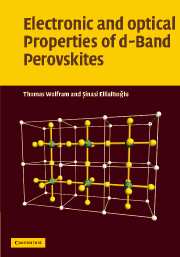Book contents
- Frontmatter
- Contents
- Preface
- 1 Introductory discussion of the perovskites
- 2 Review of the quantum mechanics of N-electron systems
- 3 Empirical LCAO model
- 4 LCAO energy band model for cubic perovskites
- 5 Analysis of bands at symmetry points
- 6 Density of states
- 7 Optical properties of the d-band perovskites
- 8 Photoemission from perovskites
- 9 Surface states on d-band perovskites
- 10 Distorted perovskites
- 11 High-temperature superconductors
- Appendices
- Index
4 - LCAO energy band model for cubic perovskites
Published online by Cambridge University Press: 23 December 2009
- Frontmatter
- Contents
- Preface
- 1 Introductory discussion of the perovskites
- 2 Review of the quantum mechanics of N-electron systems
- 3 Empirical LCAO model
- 4 LCAO energy band model for cubic perovskites
- 5 Analysis of bands at symmetry points
- 6 Density of states
- 7 Optical properties of the d-band perovskites
- 8 Photoemission from perovskites
- 9 Surface states on d-band perovskites
- 10 Distorted perovskites
- 11 High-temperature superconductors
- Appendices
- Index
Summary
In Chapter 1 a qualitative description of the energy bands of perovskites was developed starting from a simple ionic model. It was argued that the essential electronic structure of the perovskites is derived from the BO3 ions of the ABO3 compound. The A ion was shown to be important in determining the ionic state of the B ion. Also, the A ion contributes to the electrostatic potentials. However, the energy bands associated with the outer s orbitals of the A ion were found to be far removed in energy from the lowest empty d bands and were unoccupied. As a result of these considerations the electronic structure of the A ion can be neglected in discussing the principal features of perovskite energy bands.
The energy bands that are electronically and chemically active are derived from the d orbitals of the transition metal (B) cation and the 2p orbitals of the oxygen anions. The deep core states of the ions produce atomic-like levels at energies far below the valence bands and may also be omitted in our discussion.
One of the first energy band calculations for perovskites was carried out by Kahn and Leyendecker [1] for SrTiO3. They employed a semiempirical approach based on the method of Slater and Koster [2] (described in Section 3.2). The model presented in this chapter follows closely the work of Kahn and Leyendecker.
- Type
- Chapter
- Information
- Electronic and Optical Properties of d-Band Perovskites , pp. 53 - 76Publisher: Cambridge University PressPrint publication year: 2006

